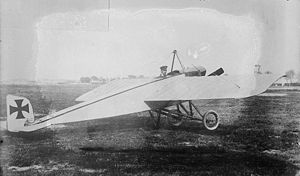Morane-Saulnier G Video - Picture

|
|
Morane-Saulnier G
Type G

Picture - A captured French Morane-Saulnier G
Role: Sport aircraft
Manufacturer: Morane-Saulnier
First flight: 1912
The Morane-Saulnier G was a sport aircraft produced in France in the years before the First World War. It was a development of the racing monoplanes designed by Léon Morane and Raymond Saulnier after leaving Borel and like its predecessors, was a conventional, wire-braced, shoulder-wing design. Construction was of fabric-covered wood throughout, except for the undercarriage struts which were of steel tube.
The type was a sporting success. In April 1913, Roland Garros took second place in the inaugural Schneider Cup in a floatplane version, finishing with a time of 40 minutes 40 seconds. On 26 June, Claude Grahame-White flew another float-equipped example from Paris to London via Le Havre, Boulogne-sur-Mer, and Dover, covering some 500 km (300 miles) that day. Between 21 and 28 September the same year, two float-equipped Type Gs competed at the seaplane meeting at San Sebastix¡n, with Lord Carbery winning the short take-off prize on one, and Edmond Audemars winning the maneuverability prize on the other. The following week, Carbery flew his Type G in the Italian Waterplane Contest from Lake Como to Pavia and back, along with two other Type Gs in the field of fifteen competitors, these flown by Garros and Morane. Garros not only won the Grand Prize in the "general class", but also the prizes for best speed (127.7 km/h, 79.8 mph) and greatest altitude (2,100 m, 6,000 ft).
In 1914, Russian manufacturer Duks arranged to build the type under licence at their Moscow factory for the Russian Army, and the same year, the Turkish military ordered 40 examples. Before these could be delivered, however, war broke out, and the aircraft were impressed into the French Army. To these, the Army soon added an order of 94 aircraft, and the British Royal Flying Corps also acquired a number, these latter machines purchased from Grahame-White, who was manufacturing the type in the UK under licence. At the outbreak of war, the type's military value was found to be wanting, and the French machines were quickly relegated to training duties.
Despite this, a dedicated single-seat fighter version was built in 1915, armed with an 8 mm Hotchkiss machine gun that fired through the propeller arc, the propeller blades being protected by deflector plates. Only one or two prototypes were built, and the type never entered service.
Some Type Gs were modified by Morane-Saulnier to have their wings mounted above the fuselage, parasol-fashion, rather than at the fuselage sides. This arrangement was found to offer far better visibility for the pilot, and formed the basis for the Morane-Saulnier L.
A Type G is preserved at the Museo del Aire de Cuatrovientos in Madrid.
Variants
Type GA - version with 40 kW (60 hp) Le Rhx´ne engine
Type GB - version with 60 kW (80 hp) Gnome engine
Type WB - version for export to Russia with glazed forward fuselage
Operators
France
Aéronautique Militaire (94 ordered, plus 40 impounded from Turkish order)
Russia USSR Spain Turkey
(40 ordered, but never delivered)
United Kingdom
Royal Flying Corps
Specifications (GB)
Data from Jane's Fighting Aircraft of World War I, 116
General characteristics
Crew: One pilot
Capacity: 1 passenger
Length: 6.30 m (20 ft 8 in)
Wingspan: 9.20 m (30 ft 2 in)
Wing area: 16 m² (172 ft²)
Empty weight: 95 kg (208 lb)
Gross weight: 370 kg (815 lb)
Powerplant: 1 x— Gnome, 60 kW (80 hp)
Performance
Maximum speed: 123 km/h (76 mph)
Rate of climb: 1.8 m/s (345 ft/min)
Green, William; Gordon Swanborough (1994). The Complete Book of Fighters. Godalming, UK: Colour Library Direct. ISBN 0862882206.
Hartmann, Gérard (2001). "L'incroyable Morane-Saulnier hydro". La Coupe Schneider et hydravions anciens/Dossiers historiques hydravions et moteurs. http://www.hydroretro.net/etudegh/moranesaulnierhydro.pdf. Retrieved 2008-11-07.
The Illustrated Encyclopedia of Aircraft. London: Aerospace Publishing.
"Italian Waterplane Contest". Flight: 1129. 11 October 1913. http://www.flightglobal.com/pdfarchive/view/1913/1913%20-%201103.html. Retrieved 2008-11-10.
Jane's Fighting Aircraft of World War I. London: Studio Editions. 2001. ISBN 0517033763.
"The Latest Morane-Saulnier Monoplane". Flight: 561-64. 24 May 1913. http://www.flightglobal.com/pdfarchive/view/1913/1913%20-%200539.html. Retrieved 2008-11-07.
"The Monaco Meeting". Flight: 450. 19 April 1913. http://www.flightglobal.com/pdfarchive/view/1913/1913%20-%200430.html. Retrieved 2008-11-07.
"Mr Grahame-Wnite's Seine-Thames Trip". Flight: 749. 5 July 1913. http://www.flightglobal.com/pdfarchive/view/1913/1913%20-%200723.html. Retrieved 2008-11-07.
"Morane-Saulnier type G". EADS website. http://www.eads.net/1024/en/eads/history/airhist/1910_1919/morane_saulnier_g_1912.html. Retrieved 2008-11-07.
Taylor, Michael J. H. (1989). Jane's Encyclopedia of Aviation. London: Studio Editions. ISBN 0710607105.
Morane-Saulnier G Pictures and Morane-Saulnier G for Sale.
Living Warbirds: The best warbirds DVD series.
Source: WikiPedia